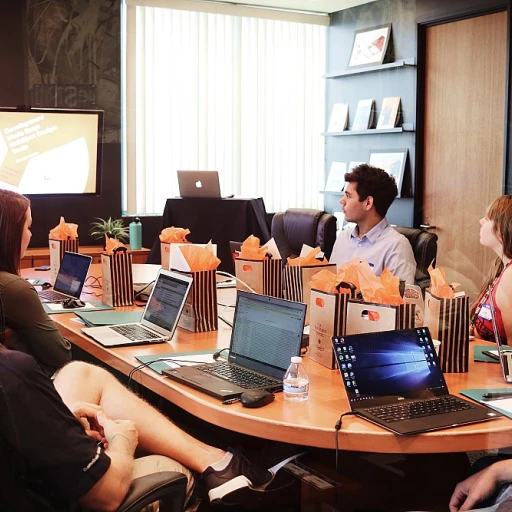
Understanding the Importance of Early Career Preparation
The Cornerstone of Career Building
Embarking on the journey of career preparation at an early age can make a striking difference in a student's life. Understanding the significance of starting this journey before stepping into the competitive job market sets a solid foundation for high school students. This preparation involves more than just academic lessons in the classroom; it's about recognizing and shaping career-ready individuals.
High school proves to be a pivotal stage where students can start exploring their interests and strengths. By identifying these early, they can harness these insights when they transition to applying for jobs. This is where skill-enhancing resources can be invaluable in providing real-world application opportunities. For instance, understanding job application forms and practicing filling them can boost confidence when students are applying for actual positions.
Students who engage in career-focused activities better understand what employers expect. Schools can integrate job-related skills into their existing curriculums, creating a cohesive learning environment that bridges education with future vocational pursuits. Students are more likely to engage in applying job concepts when these are woven into their class experiences.
Moreover, fostering an environment where students regularly practice job skills helps solidify their understanding and application of these skills. This kind of preparation aligns with tracking their progress and helps set realistic future goals. High school becomes not merely an academic stage but a stepping stone to life skills and vocational readiness.
Identifying Key Skills for Job Applications
Essential Job Application Skills for Success
Developing key skills for job applications is crucial for high school students as they prepare to enter the workforce. Understanding these skills helps students navigate the job market more effectively and boosts their confidence when applying for positions. To begin with, cultivating strong communication skills is essential. This encompasses both written and verbal communication, which are vital when filling out application forms, crafting resumes, and during job interviews. Engaging in classroom activities like role-playing interviews can significantly enhance these skills. Moreover, students should focus on developing organizational skills. The ability to manage time well and prioritize tasks is invaluable when juggling multiple responsibilities, whether in educational settings or the workplace. Problem-solving is another critical area, and students can practice this through interactive exercises. By integrating problem-solving into the lesson plan, educators help students tackle real-world challenges they might face in their future careers. Furthermore, high school students can benefit from understanding how to present themselves professionally. This includes learning how to dress appropriately for different job scenarios and how to conduct oneself in professional settings. Researching potential career paths is also a vital skill. Encouraging students to explore various vocational opportunities will aid them in making informed decisions about their future career goals. Utilizing resources like sample job descriptions can help students gain insights into professions of interest. Support for these endeavors can be found through platforms that integrate automated skill matching (learn more here). This can provide valuable guidance tailored to each student's aspirations and skills. Ultimately, by focusing on these key job application skills, educators can help students build a strong foundation for career readiness, making the transition from education to the workforce smoother and more successful.Interactive Activities to Enhance Job Application Skills
Interactive Exercises that Make a Difference
In the realm of preparing high school students for their job application journey, hands-on activities can be revolutionizing. These exercises not only make learning more engaging but also bridge the gap between theoretical knowledge and real-world application. Implementing interactive activities in the classroom can significantly enhance students' job application skills, building their confidence as they gear up to enter the workforce. To effectively foster job application skills, educators can integrate mock interviews and role-playing scenarios in their lessons. These activities provide students with a safe space to practice their responses to typical job interview questions. Employing real-life scenarios helps in immersing students fully, allowing them to navigate the nuances of professional communication. Moreover, teachers might consider using technology to their advantage. Digital tools such as Google Slides can be incorporated into the classroom for conducting interactive workshops where students fill out sample job applications and receive instant feedback. This not only refines their skills but also makes the learning process enjoyable for students. Engaging with classmates in collaborative activities can also elevate the learning experience. Group projects can simulate team-based tasks common in workplaces, thereby instilling essential skills such as communication, problem-solving, and teamwork. Integrating specific lesson plans focused on life skills and career readiness can benefit students immensely. Such lessons should include guidance on writing cover letters and resumes, addressing job-specific requirements tailored to different vocational paths. Through these tailored activities, school students will learn to present their skills effectively, whether they are applying to colleges or seeking entry-level job opportunities. In essence, interactive activities empower students by catering to diverse learning styles, ultimately enhancing their capability to apply for jobs effectively. With the right tools and support, high school students will not only be equipped for the job market but will also be confident in their professional pursuits.Utilizing Technology for Skill Development
Leveraging Technology to Boost Skill Development
In today's digitized world, technology offers vast resources that can greatly enhance the process of developing job application skills for high school students. Educators can leverage these resources to make the learning process more engaging and efficient. Interactive platforms like Google Slides allow students to creatively present their career readiness lessons and practice job applications in a fun and interactive manner. By using online templates and digital forms, students can simulate real-world job application experiences. This hands-on approach enables them to become familiar with the layout and content of various application forms, boosting their confidence when it's time to apply. Additionally, vocational education programs can utilize technology to simulate job interviews and create practical scenarios that reflect real-life challenges. Through virtual classrooms or online simulations, students can practice their verbal communication and experience firsthand what employers expect during the hiring process. Technology also supports the creation of personalized lesson plans tailored to individual needs, which is particularly beneficial for school students requiring special education support. Tools like educational apps and platforms provide access to an array of resources in job skills, application students can explore extensively at their own pace. Incorporating technology in classroom lessons not only keeps students engaged but also equips them with life skills critical for the workplace. Educators play a crucial role in guiding students to use these resources effectively, helping them stay ahead in their career preparations. Through ongoing classroom activities and career-related exercises, high school students build a robust foundation in job application skills, setting the stage for successful endeavors in applying job roles in the future.Building a Supportive Environment for Learning
Creating a Nurturing Environment for Skill Development
In high school settings, nurturing a supportive environment is crucial for fostering job application skills among students. Schools can focus on creating an inclusive classroom atmosphere where students feel encouraged to take risks and engage in various skill-enhancing activities. Let’s look at some practical steps to achieve this:- Encouraging Collaboration: High school students can practice job skills more effectively when they work together on class projects or group tasks. Collaborative exercises simulate real-world job situations, allowing students to gain experience in teamwork and communication.
- Offering Peer Support: Schools can establish peer mentorship programs where students help each other with their job applications and interview preparations. This not only promotes peer learning but also builds confidence as students receive constructive feedback from their classmates.
- Incorporating Real-World Scenarios: Education systems can introduce role-playing activities where students practice job interviews or fill out job application forms. Implementing life skills lessons, like application students counseling on what employers expect, can make a significant impact.
- Providing Access to Resources: Schools could offer resources such as sample jobs and various vocational training materials. Educators can guide students to utilize tools such as Google Slides for building their digital portfolios, enhancing their job applications.
- Encouraging Participation in Vocational Classes: High schools can enhance career readiness by introducing vocational classes, allowing students to explore different job fields. These classes can significantly contribute to the development of job-specific skills.
Tracking Progress and Setting Future Goals
Keeping Track of Development and Defining Aspirations
The journey to mastering job application skills is a continuous process, for high school students and beyond. As students transition from classroom lessons to real-world applications, diligently tracking their growth is essential. Regular review of their acquired skills provides them with a clearer picture of their readiness for future career challenges. Monitoring progress can be achieved through several means, each catering to different aspects of skill development:- Creation of a Skill Development Portfolio: Encourage students to maintain a portfolio that contains their job application samples, feedback from mock interviews, and any acquired certifications from online vocational courses. This portfolio serves as tangible evidence of their skills vocational journey and can be an impressive addition to real job applications.
- Periodic Self-Assessments and Reflections: Self-assessment is a potent tool that allows students to evaluate their own strengths and identify areas for improvement. By reflecting on exercises conducted in class, such as filling out application forms or participating in interactive activities, students can set realistic goals for subsequent lessons.
- Setting Achievable Milestones: Breaking down the end goal of becoming proficient in job applications into smaller, attainable milestones helps maintain motivation. Celebrate small wins – whether it’s mastering the art of writing a cover letter or perfecting a job interview technique.












